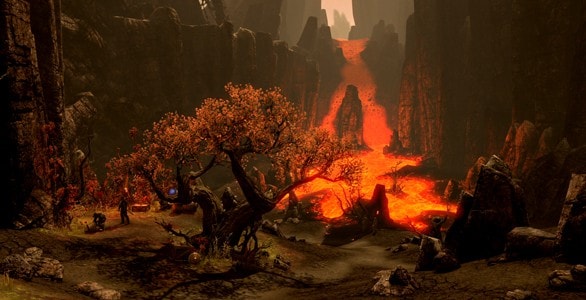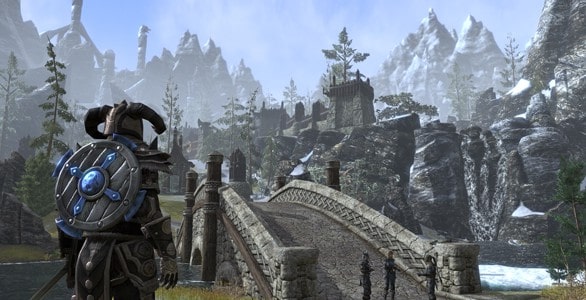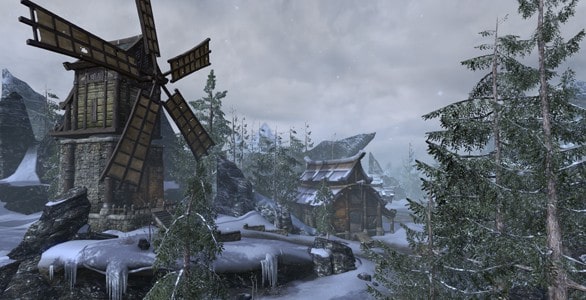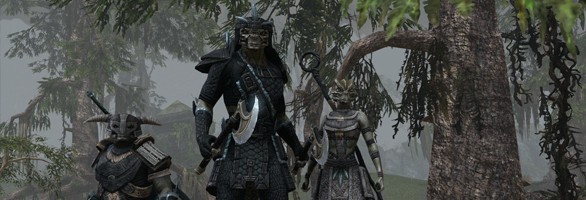Recently, MMO ATK had the amazing opportunity to visit ZeniMax Online’s Baltimore studio to experience a hands-on demo and presentation of The Elder Scrolls Online (ESO). Many doubts were cast upon the game after E3 2012’s showing when they failed to give an accurate portrayal of what the game was capable of achieving and why it will stand out as the definitive MMO experience when it finally sees release in 2013. Many feared that the game would be nothing more than a run-of-the-mills MMO, with an Elder Scrolls skin hiding its generic filling.
Fortunately, when ZeniMax Studios was handed the reins for ESO, they understood the daunting task they had before them and put every effort forth to create something truly groundbreaking. Not satisfied with making just a great MMO, they set out to make the best MMO. This meant creating a best in class RPG, an engaging social experience, and a great Elder Scrolls title.
After spending four hours experiencing what the world of The Elder Scrolls Online has to offer, I’m pleased to say that the game is shaping up to be the genre defining title ZeniMax has promised.
[heading]Redefining How We Play Together[/heading]

Social media has evolved tremendously over the past decade to the point where it is now an integral part of our daily lives. Interestingly enough, MMOs, over the same period of time, have failed to progress socially in any significant way, or to integrate the social media moguls we’re all a part of, such as Facebook, Twitter, or Google+. Bethesda and ZeniMax Online Studios described current MMOs as a social vacuum. They tend to be in their own world and ignore the direction towards which people drift in the world at large. The developers of ESO look to turn the tides of the social MMO by giving us all the lore and quality gameplay we have come to expect from The Elder Scrolls, married with an MMO context implementing two major advances: the aptly named, Megaserver, and social network integration.
So, it’s The Elder Scrolls, With Friends?

As long as there have been Elder Scrolls games, there have been people begging for the implementation of multiplayer. The one thing that could top exploring a vast, living world would be doing it with a friend. Finally, our dreams have become reality and players are free to explore the worlds they have come to love with the people they love playing with.
There are three main ways a player can choose to approach ESO: with other players, against other players, or just flying solo. While ZeniMax assures us that this, being an Elder Scrolls game, will offer an exciting, fleshed-out experience for those looking to play alone, the majority of the content was designed around and geared towards players interacting with each other: whether through cooperation or in the Player vs. Player mode.
While many of the initial missions and quests start off basic, straightforward and more easily completed alone, players will quickly be ushered into the world of public dungeons and higher-leveled creatures. At this point, it is to the player?s advantage to find their friends, or make some new ones, to work towards completion together. Doing so doesn’t simply offer the benefit of two players fighting side by side (though that is a huge benefit in and of itself) but rather, much like many of the enemies you’ll come across throughout Tamriel, players supplement each other through synergy.
Though hardly a new concept, the implementation of synergy is perhaps best described through the live demonstration, presented to us first hand. On screen, two characters, a mage and warrior, approach a high level Lich: a necromancer with the ability to summon skeletons. Alone, neither character stands much of a chance, so the two must be in sync to succeed. Before battle, the mage prepares the team by casting a spell which gives all players in range a temporary stats boosts. Once fully charged, the warrior runs in to initiate battle and starts dealing physical damage. While this is going on, the mage deals magical damage by casting an electricity spell from a distance. With each cast of the spell, the warrior, who is in range of each landed spell, has the ability to act upon it and deal a supplemental amount of damage. He is literally working to enhance the mage’s efforts. The key aspect in this strategy is that the extra damage doesn’t happen automatically. The player within range must initiate the opportunity, meaning that players must be in sync and cooperative while on a team. Where each character individually would have struggled to take down the Lich, together they managed the affair without issue.
Even in the heat of battle, players are able to work together to create a team that is stronger than the sum of its parts. The unique implementation of synergy, coupled with ESO’s intuitive combat system, should keep battles fresh and intense while keeping players on their toes.
Megaserver: Why you should care.

Of all the features that define an MMO, the ‘shard’ server system seems to make the least amount of sense. If you’re playing on one server, and your friends happen to be playing on another, it is a huge hassle and process to trade servers and meet up with them. It is an issue that completely removes the user from gameplay and damages the overall experience. For a game that is meant to be social, it inhibits itself naturally through the separate servers.
ZeniMax approached the broken system and asked how it can be fixed? The result of their labors is a system coined: Megaserver. To put it in basic terms, Megaserver is one giant server that houses every player. No longer are you forced to jump through hoops to join friends, as the confusing shard systems of the past no longer alienate new players from meeting up. Everyone is together.
Of course, this is not to say that every player is thrown into a single game world. If that were the case, the world would be vastly over-populated and any possibility of enjoyment would be minimal. ZeniMax is well aware of this, and has prepared accordingly. Game director Matt Firor likened the system to that of Xbox Live, where everyone is playing on the same online service, but there are multiple games taking place simultaneously within it. Much along the same lines, there will be multiple instances, or game worlds, on the server that players can jump back and forth between at will to meet up with friends or various different groups.
ZeniMax says they are still toying with the number of players allowed in each world, but they assure that they will find a happy balance to ensure the best possible play experience. Once they decide on a maximum number per play world, they plan to cap off new entries just below the maximum to guarantee that players can still jump in to meet up with friends. No more full servers, and no more ghost towns — everything is balanced and fun.
Worried about finding the world that feels right for you? ZeniMax’s systems will be hard at work to bring you your optimal experience. Before you start your ESO game, it will take you through a brief questionnaire to find your gameplay preferences to place you in a game uniquely tailored to your tastes. Prefer to play alone? Simply acknowledge this in the questionnaire and the game will automatically place you in a game where others feel the same.
Even more than this, ESO recognizes when you’re getting along with other players. In what is one of the coolest features of the game, the system will try to pair you with players who you have played and worked well with before. Even if all your friends are offline, or you have none to your name, the game instinctively tries to make you new ones. The goal is to never have a player feel isolated or overwhelmed when jumping into a game.
Everything Changes When the Enemy is as Smart as You

Those looking for less an opportunity to work with each other, and more of a chance to rip others apart will be pleased to hear of the robust Player vs. Player system in the works. In The Elder Scrolls Online, players are divided into one of three different groups, based on the region they belong to: Ebonheart Pact, Daggerfall Covenant, or Aldmeri Dominion. Players who reach level 50 are ushered into the PvP world to fight over the heart of Tamriel: Cyrodiil.
Once in Cyrodiil, players must work as a team to compete against other regions to dominate the land. Various cities and keeps are all up for grabs, including the Imperial City, which promises an important title to the controlling region’s MVP. The single, skilled player at the top of the leaderboard for the team that controls the capitol city will be named Emperor of Cyrodiil. While brag worthy in every right, the title should be cherished, as battles rage around the clock and there’s no saying that control of the City will last long.
Each battle can range from small scale, to upwards of hundreds of players per team simultaneously. The more aggressive the approach and planning, the higher the reward will likely be. Even in PvP, teamwork plays a vital role in dominating the map.
ZeniMax confirmed that players who are not yet to level 50 will still have the option to enter into the PvP world at an increased level, which gives them a fighting chance while still allowing those who reached level 50 a distinct advantage. Players who are looking to improve their inventory while in PvP will be out of luck, as looting a defeated player will not be an option. When asked why this is (as looting is a key part to an Elder Scrolls experience), one developer stated that it wouldn’t be fair to the defeated player and that the cost of death would be too significant to encourage continuous PvP play.
Looking at how PvP will work in regards to the multiple game worlds (or instances) occurring on the Megaserver presents a unique problem. The games need to remain balanced in terms of number of players, but still must keep progress for each region across all game worlds in check. It sounds confusing and a solution is over our heads here at MMO ATK, but ZeniMax says they do have a plan in place that will be fair to everyone playing, no matter what game world you happen to be in, but they won’t be ready to discuss specific details until the feature gets implemented fully.
Modern Social Experience

It was mentioned before how ZeniMax views the MMO industry as being in a social vacuum. ZeniMax looks to capitalize on the social network explosion by implementing it straight into the game. Facebook plays an important part in helping to shape our ESO experience. Now, organizing your friends or a guild is as easy as making a group on Facebook. Simply invite and organize on Facebook and import the player roster straight to the game. Just like that, you’re set to play. The concept is so simple and intuitive that it is amazing that no one has seen the potential until now. ZeniMax has also promised Twitter and Google+ support, but specific details are still up in the air.
[heading]World Immersion[/heading]

One of the most unique aspects of any Elder Scrolls title is the ability to completely immerse the player in a living world. In ESO, the world is vast and varied. When you walk through the wilderness, deer, rabbits and wolves inhabit your surroundings and react to your actions. NPCs can be found wandering throughout villages going about their own daily tasks. You really feel as if all of the NPCs have their own lives to tend to. While not all of them have quests for you to complete (though many do), they all serve the purpose of surrounding you in a living, breathing world.
One of the most alarming and effective methods of immersing the player in the world is by giving them quest decisions. Much like choosing between the Imperials and the Stormcloaks in Skyrim, various quests ask the player to decide how to approach a situation. Sometimes you must choose whether you find all of the characters that have gone missing, or if you leave with only a handful of them? Do you assist the battle waging on the docks, or go to defend the fort? Putting the option in the hands of the player puts weight on each decision, as the consequences can have an effect on future engagements. When an NPC dies at the hand of your decision, they are dead forever, while those who you choose to save will become familiar faces down the line. There are significant consequences at stake with each fork in the road, which makes each choice an important one.
[heading]Strategic and Reactive Combat[/heading]

ZeniMax Studios didn’t just set out to make The Elder Scrolls Online look like an Elder Scrolls game, they wanted it to feel like one as well. Those familiar with the PC version of past Scrolls titles will feel right at home with the combat controls. A left click attacks, while a left hold builds a power swing, and a right click/hold raises the shield.
Gone are the days of MMO combat in which once engaged, your character plays out the battle for you, leaving you with nothing to do but activate hot keyed abilities and items. Battles in ESO are much more involved and 1:1 in nature. The player is in control of each action, every step of the way. It is a system that sounds simple, yet has surprising depth. For example, when an enemy charges a power attack, the player can right click to block and stun the enemy, and follow up with a left click to attack and inflict critical damage. This is yet another way in which ZeniMax is looking to tailor an experience around the player. It’s straightforward and it all makes sense.
Much like a spell in Oblivion, or a Shout in Skyrim, you also have secondary spells and abilities that you can use to your advantage throughout battle at the expense of Magicka. The higher you level up or the more you use certain abilities, the more advanced abilities you unlock. Players can equip various abilities to a custom number (1-6) for quick use in battle to help tip an advantage.
[heading]Unique Progression[/heading]

The Scrolls series has always taken a unique, open approach to character progression. In the majority of MMOs, you choose your character, you choose your class, and that’s it. If you’re a mage, you’re a mage. Certain items are even blocked from your possession. Being stuck with that decision for the duration of the game fails to encourage or allow any sort of experimentation. The Elder Scrolls Online doesn?t do that. Instead, regardless of initial character decisions, players have free reins to explore their interests by means of any weapon or armor sets they please. Full customization is available to create any character the player sees fit.
When determining class, different races will have varying stats in terms of health, magicka and stamina, and abilities are unique to different classes. But, where your character starts is no indication of where he/she has to go. Any weapon and any armor are at the complete disposal of every player. You’re free to become a warrior, a mage, or any combination of classes that you see fit. Fairness and balance come naturally to this idea of open class customization as there isn?t any one armor or weapon set at the disposal of one character that isn?t available to everyone else.
[heading]My Take?[/heading]

Before coming into the presentation and hands-on demo, I will admit, I knew very little about The Elder Scrolls Online. I knew the game was in the works, but I was hesitant as to how the MMO aspect would be implemented into the world that I held so dearly to my heart. Coming out, I feel confident in saying that the game will satisfy and impress many as it combines the best that The Elder Scrolls has to offer, while implementing a redefined MMO experience.
For my time with the game, I played as a Dark Elf Dragonknight, one of the two classes available during the demo, but only one of several that will be available with the final build. My adventures in the Ebonheart Pact (the only covenant available of three at this point) started on Bleakrock, a small island belonging to Skyrim, and eventually progressed to the Morrowind city, Bal Foyen. I only cracked the surface of what the game has to offer, but I got a great feel for what it has to offer.
The first thing you will notice is how good the game looks. The environments are vast and detailed and each province of Tamriel that you explore has the distinct feel and look that you will remember from previous Elder Scrolls entries. From the cold, mountainous region of Skyrim, to the strange, otherworldly look of Morrowind, great attention to detail went into recreating each area.
The game controls very well. The combat is responsive and intuitive, and considering the Alpha stage it was in, the game was remarkably stable. That being said, one feature that I found to be rather underwhelming was the first person view option. While I am glad to see its inclusion, it seems to be a feature implemented simply as a means to get a better view of an area. While in it, neither of your character’s arms, hands, weapons, etc. appear on screen making it extremely inconvenient when engaging in battle. Distances are difficult to judge and I was never really sure if my attacks were landing. I have hopes that a better first person mode will be included in the final build, but I will understand for various reasons if they decide not to. While it’s certainly not a deal breaker, I played both Oblivion and Syrim entirely in a first person view and I’d feel much more at home doing the same with ESO.
In terms of gameplay, ZeniMax knows that the audience is tired of the basic collection quests that plague the genre and is putting in great efforts to ensure that missions of this type only play a small part in a wide variety of quest tasks. Indeed, in my brief (compared to the entire scope of the game) play experience, I didn’t come across a single collection quest. Enemies weren’t mandatory to kill to complete the quest as they are in some games, but rather, were obstacles in which I had a choice to approach head on or sneak around. It gives the player the sense that they have control over how a quest plays out and they are free to play the way they want.
My time with The Elder Scrolls Online has left me wanting more. The game is successful in bringing the immersive world of The Elder Scrolls to the MMO world to give the genre a breath of fresh air. With a release date of 2013, ESO is a game to keep on your radar, because when it launches, it has all the makings to be something big.
For continued coverage of The Elder Scrolls Online, be sure to keep up with us here at MMO ATK. Follow us on Twitter and Facebook to get the updates on all the latest news and information.
More Elder Scrolls Online Information
Interview with Matt Firor, Game Director at ZeniMax Online Studios.
Interview with Brian Wheeler, PvP Director at ZeniMax Online Studios.

